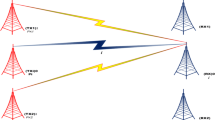Abstract
The effect of electromagnetic radiations from wireless cellular telephony systems on human health has been intensely discussed. As a result, and despite the lack of evidence on any adverse effects, recent regulations make network planning even more difficult. Base stations, even those covering urban areas, tend to be placed at suburban locations (in this paper we cite some examples of related local regulations). In these cases, mobile stations inside urban locations must raise their power transmission level to reach suburban antenna placements. Therefore, users may complain of a higher radio exposure. In this work we propose a feasible solution to reduce electromagnetic activity from mobile communications equipment and to cope with restrictive placement regulations. To accomplish this goal, a suburban base station is divided into an active part (transmitter) that is kept at the suburban location, and a passive part (receiver), which is moved inside the urban area. Thereby, the power received from the base station can be considered negligible inside the urban area (since the active part is far away), and mobile terminal/stations transmit lower power levels (since passive receivers are close to them). We justify the solution in the context of the globally available GSM networks, both analytically and with empirical and simulation tests. The results in this paper reveal that our approach reduces electromagnetic levels and improves uplink quality, which reaches typical levels of urban base stations.
Similar content being viewed by others
References
Moulder, J. Cellular phone antennas (mobile phone base stations) and human health web site. [online]. Available: http://www.mcw.edu/gcrc/cop/cell-phone-health-FAQ/toc.html.
United Nations International EMF Project. [Online]. Available: http://www.who.int/peh-emf/project/en/.
Cell Phone Facts. Consumer information on wireless phones [online]. Available: http://www.fda.gov/cellphones.
El mundo Newspaper. “Quinto caso de cáncer infantil en el colegio García Quintana” (fifth case of children cancer in the García Quintana school) [online]. Available: http://elmundo.es/elmundosalud/2003/11/07/oncologia/1068206123.html.
Townsend, D. A. Report on: The national antenna tower policy review. Industry Canada Registration Number 54220B [online]. Available: http://strategis.ic.gc.ca/epic/internet/insmt-gst.nsf/en/sf05353e.html.
Mast-Victims.org—Raising awareness of the harmful effects of cellphone masts [online]. Available: http://www.mast-victims.org.
Community Board #1 resolution, Queens, City of New York, Nov 20, 2003. Available: http://www.stopradiation.org/pics/communityresolution.JPG.
The Times Newspaper. New York: Manhattan: More oversight urged for cell towers [online]. Available: http://query.nytimes.com/gst/fullpage.html?res=950DEED9163BF93AA25752C1A9659C8B63.
The International Commission on Non-Ionizing Radiation Protection ICNIRP. [Online]. Available: http://www.icnirp.de/.
Ayuntamiento de Santiago de Compostela (Santiago de Compostela Town Council), Plan General de Ordenación Urbanística de Santiago (General Urbanization Plan of Santiago), Chap. VIII, Article 194.
Ayuntamiento de León (León Town Council), Moción instando al gobierno de la nación a que reduzca al menos en un 50% los niveles de intensidad de campo eléctrico de referencia y los correspondientes límites de exposición a las emisiones radioeléctricas recogidos en el Real Decreto 1066/2001 (Proposal requesting the national government at least a 50% decrease in the reference levels of electrical field intensity and the corresponding limits of exposure to radioelectric emissions indicated in Real Decree 1066/2001), approved March 31 2006.
Bath & North East Somerset Council. Mobile phone masts—A policy for the granting of agreements on Council owned property [online]. Available: http://www.bathnes.gov.uk/Committee_Papers/Executive/Exec031001/10MobilePhoneMasts.htm.
Salford, G., Brun, A., Eberhardt, J., Malmgren, L., & Persson, B. (2003). Nerve cell damage in mammalian brain after exposure to microwaves from GSM mobile phones. Environmental Health Perspectives, 11(7).
Reuters. (2004). Study: Cell phones scramble DNA [online]. Available: http://dynamics.org/Altenberg/MED/CELL_PHONES/2102-1039_3-5498198.html.
Adlkofer, F., et al. (2004). Final summary offered for Europe’s REFLEX project. The Bioelectromagnetics Society Newsletter, 181(6).
García-Sánchez, M., Cuiñas, I., & Vázquez-Alejos, A. (2005). Electromagnetic field level temporal variation in urban areas. Electronics Letters, 41(5).
Cuiñas, I., García-Pino, A., García-Sánchez, M., Arias, M., & Alonso, A. A. (2004). Fixing limits to free-access areas around broadcast antennas. IEEE Transactions on Antennas and Propagation, 52(10).
Redl, S., Weber, M., & Oliphant, M. (1995). An introduction to GSM. Artech House.
3GPP (TS 05.08) Digital cellular telecommunications system (Phase 2 +); radio subsystem link control 3GPP. Technical specification 05.08 v. 8.22.0.
Rappaport T. S. (2002) Wireless communications, principles and practice, 2nd edn. Prentice Hall, Prentice
Andrew dipole antenna. [online]. Available: http://www.andrew.com/products/antennas/bsa/DB810KE-SY.aspx.
Kathrein dipole antenna. [online]. Available: http://www.kathrein.de/de/mca/produkte/download/936450j.pdf.
Andrew panel antenna. [online]. Available: http://www.andrew.com/products/antennas/bsa/DB878H120ESY.aspx.
Kathreint panel antenna. [online]. Available: http://www.kathrein.de/de/mca/produkte/download/936742e.pdf.
Commercial fractal antennas. [online]. Available: http://www.fractus.com.
OPNET Modeler. [online]. Available: http://www.opnet.com/products/modeler/home.htm.
OPNET Wireless Module. [online]. Available: http://www.opnet.com/products/modules/wireless_module.htm.
OPNET GSM contributed model. [online]. Available: http://www.opnet.com/support/cont_models.htm.
COST 231 Walfish-Ikegami Model. [online]. Available http://www.ee.bilkent.edu.tr/~microwave/programs/wireless/prop/costWI.htm.
Author information
Authors and Affiliations
Corresponding author
Rights and permissions
About this article
Cite this article
Vales-Alonso, J., González-Castaño, F.J., Muñoz-Gea, J.P. et al. Decoupled Active/Passive Base Stations for Second Generation Cellular Networks. Wireless Pers Commun 56, 255–275 (2011). https://doi.org/10.1007/s11277-009-9831-z
Published:
Issue Date:
DOI: https://doi.org/10.1007/s11277-009-9831-z




